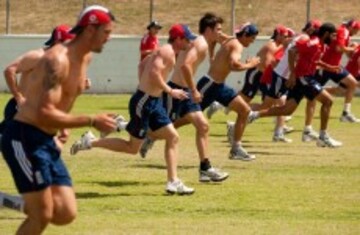IT’S ALMOST FEBRUARY, so we’d expect most GAA clubs in the country have gotten back to some form of pre-season training by now.
Incorporated in those gruelling Tuesday and Thursday night slogfests are everything from sand-dune runs, to laps of the field, to circuit training, to military-style training, to boxing.
Some training techniques have come and gone, but the Bleep Test — or multi-stage fitness test — is still one of the best ways to weed out those who enjoyed Christmas a bit too much.
Originally used as a way of monitoring the fitness of personnel working in the police service, army, military and sea cadets, the Bleep Test became synonymous with team sports in the late 1980s and is still widely used today.
Here’s how it works:
The test involves continuous running between two lines, 20 metres apart, in time to recorded beeps — preferably on concrete or wood flooring. Hence why it’s called the Bleep (or Beep) Test.
The subjects stand behind one of the lines facing the second line, and begin running when instructed by the recording. The speed at the start is slow. The subject continues running between the two lines, turning when signalled by the recorded beeps.
If the line is reached before the beep sounds, the subject must wait until the beep sounds before continuing. Each level incorporates 10 shuttle runs, after which a sound indicates an increase in speed, and the beeps will become closer together.
This continues each minute. If the line is not reached before the beep sounds, the subject is given a warning and must continue to run to the line, then turn and try to catch up with the pace within two more ‘beeps’. The test is stopped if the subject fails to reach the line for two consecutive ends after a warning.
Scoring: This is where the ridiculing starts. The athlete’s score is the level and number of shuttles (20 metres) reached before they were unable to keep up with the recording. So if a person got to level ‘10.7’, it would mean they got to Level 10, and the seventh shuttle run on that level. Three more successful runs and he or she would have made Level 11.
There are 21 levels in total. Lance Armstrong and David Beckham are two of the more well-known sportspeople who have finished out the test.
Fancy trying it yourself? All you need is a non-slip surface, marking cones, 20-metre measuring tape, Bleep Test audio and a whole lot of motivation.
And to help you, here’s that audio… spit bucket at the ready!









Jamie Cudmore up against O’Connell yet again. This one could get spicy.
Culmore isn’t fit to lace O Connells boots.
Cudmore is a thug and O’Connell is a legend of the game. No competition.
I agree Cudmore is a thug. But jesus he put in a shift today. Credit where credit is due and all that…
Cudmore and Lee smashed OConnell &Co backwards all night long.
Cmon the red army.
Best dressing room ever!!
I hope Munster don’t lose.they done enough whinging on here when they won against ulster the other week.imagine the cribs and crystal from them if they lose
Christmas can come early tonight…..Come on Munster!
Jesus Christ munster are brutal
A loss would end Munsters interest? That’s a tad presumptuous, a loss would be a major setback but they’d still have every chance to go through!
Come on Munster!!
Which Clermont will show up??should be a great contest..
Munsters game plan.
Do nothing for ages.
Get into the Clermont half
Drop the ball
Some first half performance from clermont, one of the best I’ve seen from an away side at thomond park.
Well done Clermont. Massive defense. Better team all round. Munster just not at the races today.
Munster tackling isn’t great.
Amazing from Clermont. Convincing winners. Completely deserved that. Their fans were amazing too. #16th man.
Munster need to pull out socks up rapidly. Keep it simple… simple.
Barnes… the rules apply to both teams hy the way
So many knock-on’s at crucial moments, most of them from Cronin.
Not good enough at this level.
Does wayne barnes be watching something entirely different to the rest of us?
thetruth, we’re not blaming the referee this time. He was 80% correct all evening. Munster just did not play the way we hoped they would.
#BringinJOE in for this team talk
Munster half backs are awful today.
They were behind a failing breakdown, so Murray was under enormous pressure all the time, so I wouldn’t blame him too much, but Keatley was pretty poor all round I thought.
Munster are just handing this game to Claremont
Clermont may have the points so far, but watching Munster, I can’t see them losing this. Come on the boys in red.
Wrong Peter.
All smart after the fact, eh, captain hindsight?
Munster made basic errors. Our kicking game was very poor. We butchered three separate mauls by dropping the ball and set piece was hit and miss. Injury meant there weren’t quality bench players to call upon and just beaten at our own game by a superior side.
keatley’s kicks tonight…??!
Media’s darling Conor
Murray’s kicks were even worse. Gerry Thornley won’t be able to do his usual love in if he’s reporting this game.
Clermont were up for this match tonight. Hugely intense & Munster couldn’t deal with it especially up front where Munster planned to dominate.
Some match as intense as a full test match.